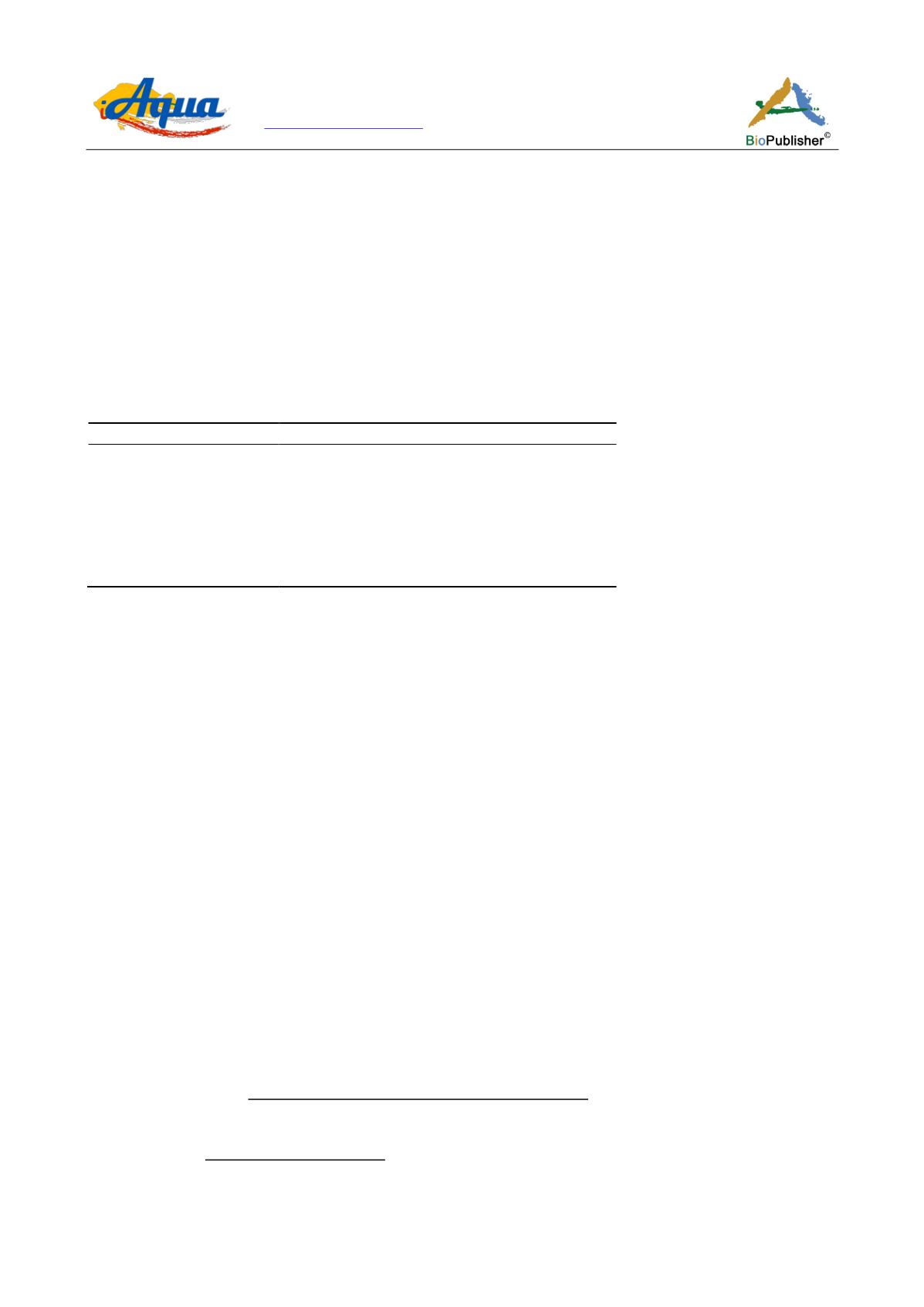
International Journal of Aquaculture, 2018, Vol.8, No.18, 137-144
138
aim of this study is to evaluate the effect of stocking density on the survival and growth of
H. occipitalis
(Günther,
1858) tadpoles in controlled medium from Benin.
1 Material and Methods
1.1 Experimental process
Tadpoles of
H. occipitalis
used in the current experiment were obtained by semi-artificial reproduction on the site
of the Research Laboratory on Wetlands (LRZH) of the University of Abomey-Calavi. Mean value of the water
temperature, pH and dissolved oxygen of the semi-artificial reproduction medium were respectively 28.33 ±
0.09°C, 7.01 ± 0.01 and 3.98 ± 0.02 mg/L. A week after hatching, tadpoles harvested with dip nets were
transferred in experimental circular plastic ponds. They were fed on live food (zooplankton and nauplii of
Artemia
salina
). Live food was progressively substituted by commercial feed (Coppens) according to Table 1.
Table 1 Planning of
Hoplobatrachus occipitalis
tadpoles feeding
in closed circuit in the laboratory
Duration (days)
Feed
2
2
1
1
1
1
16
100% zooplankton
Artemia salina
50% + zooplankton 50%
Artemia salina
75% + zooplankton 25%
Artemia salina
100%
Artemia salina
50% + artificial feed 50%
Artemia salina
25% + artificial feed 75%
Artificial feed 100%
Note: Artificial feed = Coppens 0.5-0.8 mm, 56% protein and 15% lipid
The experiment was led for 24 days in 12 circular plastic ponds (Diameter: 24 cm; volume: 60 L) containing 6 L
water each. Tadpoles (initial mean weight 0.284 ± 0.033 g) were distributed in four different densities:
5 tadpoles/L (D
1
), 10 tadpoles/L (D
2
), 15 tadpoles/L (D
3
) and 20 tadpoles/L (D
4
). Water renewal was continuous.
Densities were chosen based on the preliminary experiments on the stocking density of other frog species (Murray,
1990; Martìnez et al., 1996; Flores-Nava and Vera-Muñoz, 1999). Tadpoles were daily fed manually every
2 hours from 8 a.m to 6 p.m on Coppens fish feed (0.5-0.8 mm diameter, 56% protein and 15% lipid) at 6% of
body weight.
During the experiment, remained feed and feces were siphoned twice a day before feeding and renewal, at 7:30
a.m and 6:30 p.m. After siphoning, water volume in each pond was adjusted and dead tadpoles were counted and
weighted.
Water quality monitoring was carried out by the measurement of physico-chemical parameters such as
temperature, dissolved oxygen and pH. To measure these parameters, a portable multi meter (Calypso ORCHIDIS
SN-ODEOA 2138) was used (7:30 a.m. and 5:30 p.m.). Nitrites (N-NO
2
, according to diazotization method),
nitrates (N-NO
3
, according to cadmium reduction method) and ammoniac (N-NH
de
, according to salicylate
method) were measured by using a spectrophotometer (HACH). Control fishing was carried out every 3 days
following by ponds emptying and cleaning. Number and biomass of tadpoles were measured by pond. Feed ration
was adjusted consequently. After 24 days rearing, all tadpoles were collected from ponds and weighted.
Zootechnical performances such as Specific Growth Rate (SGR), Survival Rate (SR), Daily Weight Gain (DWG)
and Feed Conversion Rate (FCR) were calculated according to the following formula:
SGR (%/day) = 100 ×
Ln(final mean weight) − Ln(initial mean weight)
experiment duration(days)
SR (%) = 100 ×
final number of tadpoles
initial number of tadpoles


